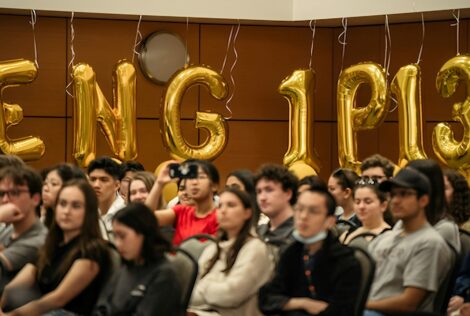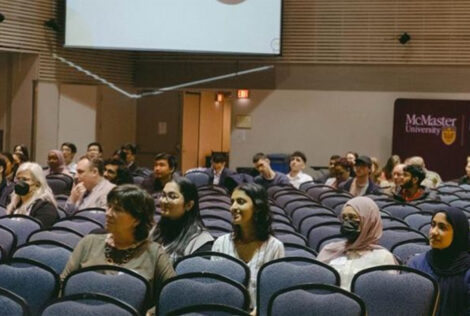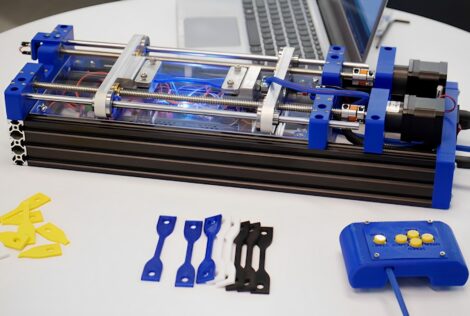
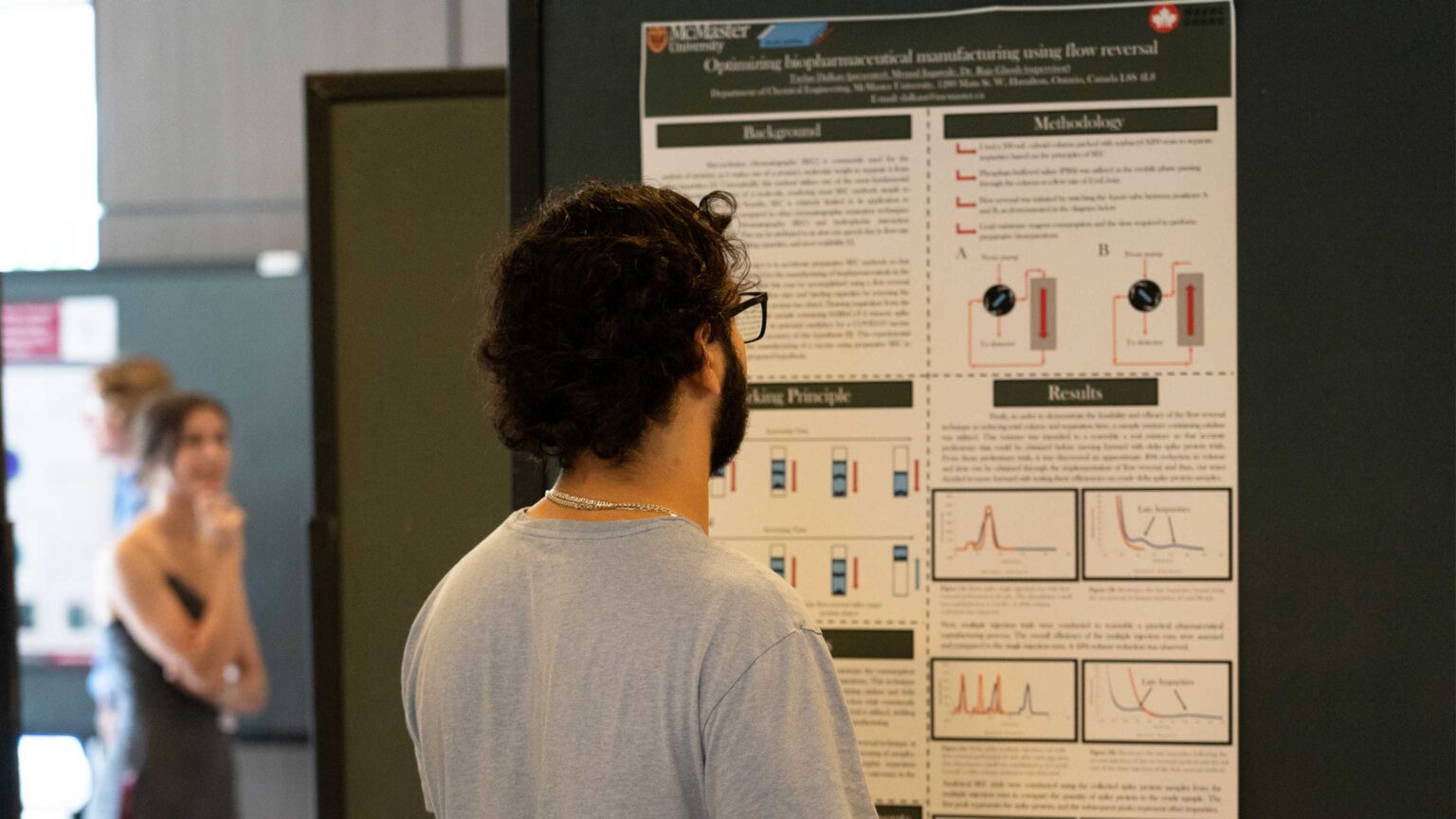
On August 17, the John Hodgins Engineering Building Lobby became a vibrant hub as students, faculty, staff and community members gathered for the Ice Cream Social & Summer Research Showcase.
The annual event, organized by the McMaster Society for Engineering Research (MacSER) and the Engineering Co-Op & Career Services (ECCS), provided an engaging platform for the McMaster community to discover summer research projects undertaken by undergraduate students while enjoying a tasty summer treat.
With more than 50 poster presentations on display, the showcase featured diverse research topics like nuclear reactor simulations and innovative disease detection through gaming apps.
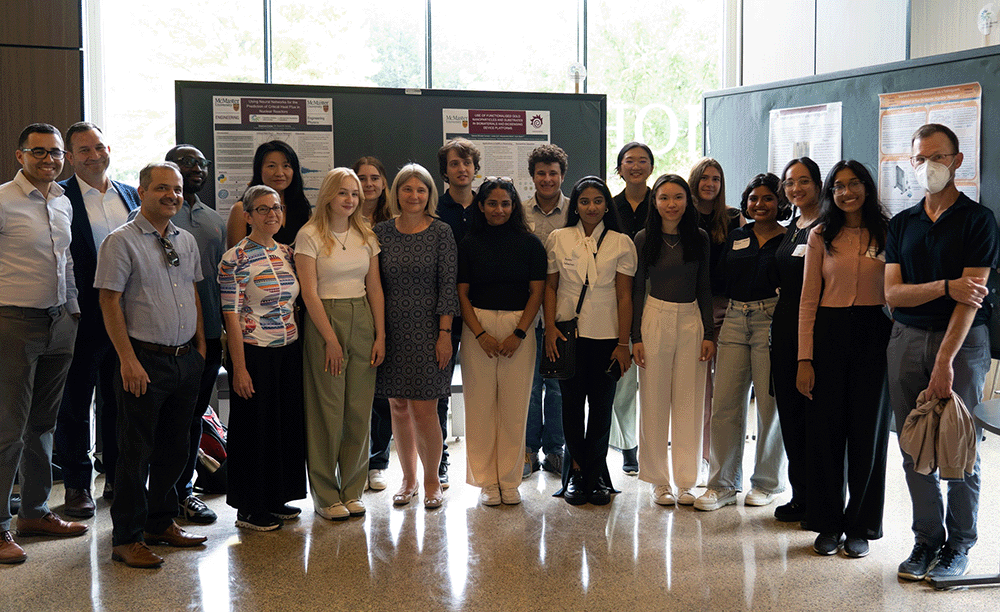
Among the students whose work was on display was our inaugural CNL Nuclear Undergraduate Research Experience program cohort, pictured above. The program is part of a partnership established in 2023 between McMaster, Canadian Nuclear Laboratories (CNL) and Atomic Energy of Canada Limited (AECL) to advance nuclear research, education and training.
Associate Dean, Research, Innovation and External Relations, John Preston and Faculty of Engineering Dean, Heather Sheardown, provided opening remarks, setting the tone for an enthusiastic day of intellectual exchange and discovery.
“We’re involved in creating new innovations that often have the potential to make a positive impact on society,” said Preston. “This is transformative because it shows that McMaster Engineering students aren’t just academically excellent, they’re also driving innovation in their disciplines. That’s something to be proud of.”
We have the largest undergraduate research program here at McMaster in all of Canada. Your involvement in tackling complex problems by pursuing lab work and presenting your findings here takes dedication and is worthy of celebration.
Through their own words, get a glimpse into the remarkable research undertaken by our accomplished Mac Eng students.
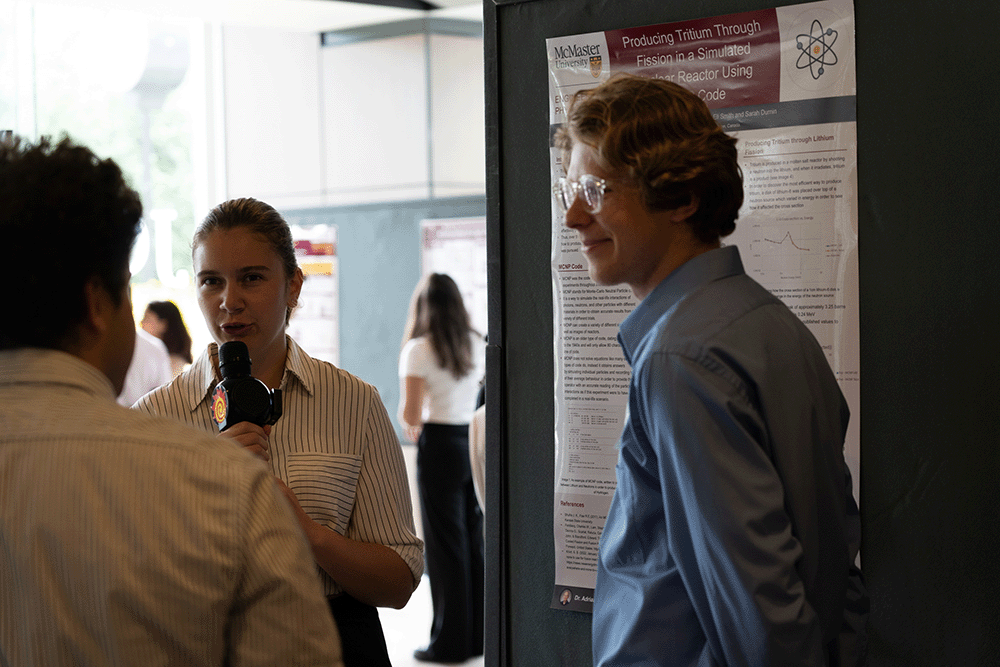
Producing Tritium Through Fission in a Simulated Nuclear Reactor Using MCNP Code
Hadeel Al-Zubaidi, Eli Smith and Sarah Durnin, Engineering Physics
Supervisor: Adriaan Buijs
Tell us about your project.
Over the summer, we’ve been collaborating with a grad student under Professor Buijs, focusing on nuclear fusion and tritium production through a lithium neutron reaction. We’re using the MCNP code, which releases numerous neutrons and allows for thorough trials and analysis. Our work mainly involves studying cross-section probabilities for fusion reactions and simulating the impact of bombarding lithium samples with neutrons. This helps us understand tritium production, a rare hydrogen isotope crucial for fusion. Additionally, we’ve been applying MCNP to examine molten salt reactors and their geometry’s influence on criticality rates. Our findings indicate that arranging fuel hexagonally enhances criticality, aligning with our goal of tritium production.
Describe a challenge you faced in your research.
We encountered various challenges throughout this journey, as much of what we tackled was entirely new to us. For instance, the code was unfamiliar territory, and we often had to turn to the manual to troubleshoot minor issues. Progressing through seemingly small steps demanded considerable time and effort, making it both a mental and technical trial. Thankfully, we overcame these hurdles by collaborating and seeking guidance from our supervisor. Essentially, we were providing coding support as part of our work with the grad student we were assisting.
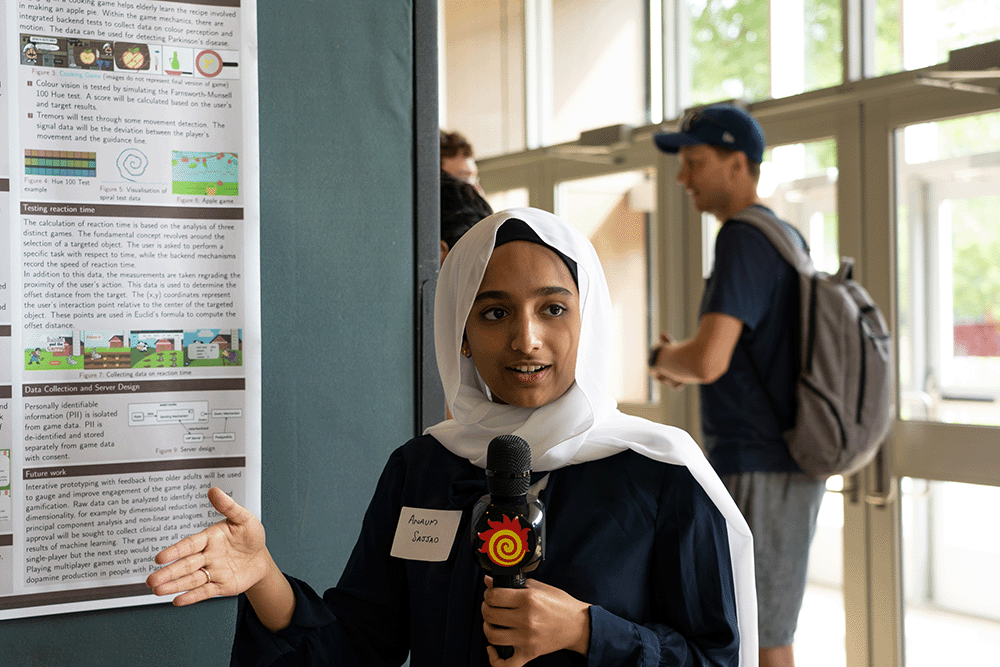
This IS Your Grandfather’s Gaming App – Tracking Parkinson’s Disease Symptoms using Games
Yashika Chadha, Lakysha Moonemalle, Anaum Sajjad, Shiyi Yang, Jingxuan Liu, Yiding Li and Habib Ghaffari-Hadigheh, Computing and Software
Supervisor: Christopher Anand
Tell us about your project.
Parkinson’s disease is a progressive neurodegenerative disorder that can cause uncontrollable movements, like tremors, poor coordination and slow reaction time. Properly diagnosing Parkinson’s is difficult—there are no X-rays or tests and smartphone apps that monitor disease progression have limitations. We decided to create a gaming app that’s both enjoyable and interactive for seniors while also tracking their disease’s progress and potential improvements. We developed 5 gaming apps, and I specifically worked on the Rabbit and Carrot app. This game centres around a target carrot that a rabbit aims to reach. The user’s task is to drag the carrot away before the rabbit gets to it. They earn points and receive positive messages, enhancing their motivation to play. The rabbit’s speed increases with more points, creating a more engaging experience. During gameplay, we gather data on their reaction time—measuring how long it takes them to notice the carrot and click on it. Since Parkinson’s can lead to uncontrolled movements, users might click in the wrong place due to tremors. We also record these instances, measuring how much their clicks deviate from the point they are supposed to click.
Describe a challenge you faced in your research.
The project presented a bit of a challenge since it was quite new and different from what I’d worked on before. Initially, I was unsure about certain aspects, like how to implement the data collection calculations. Thankfully, my team members were incredibly helpful and supportive. My coordinator and team guided me through, and I managed to overcome those obstacles. We’re nearly finished creating the game and are currently testing it with users, including seniors, to gather their feedback.
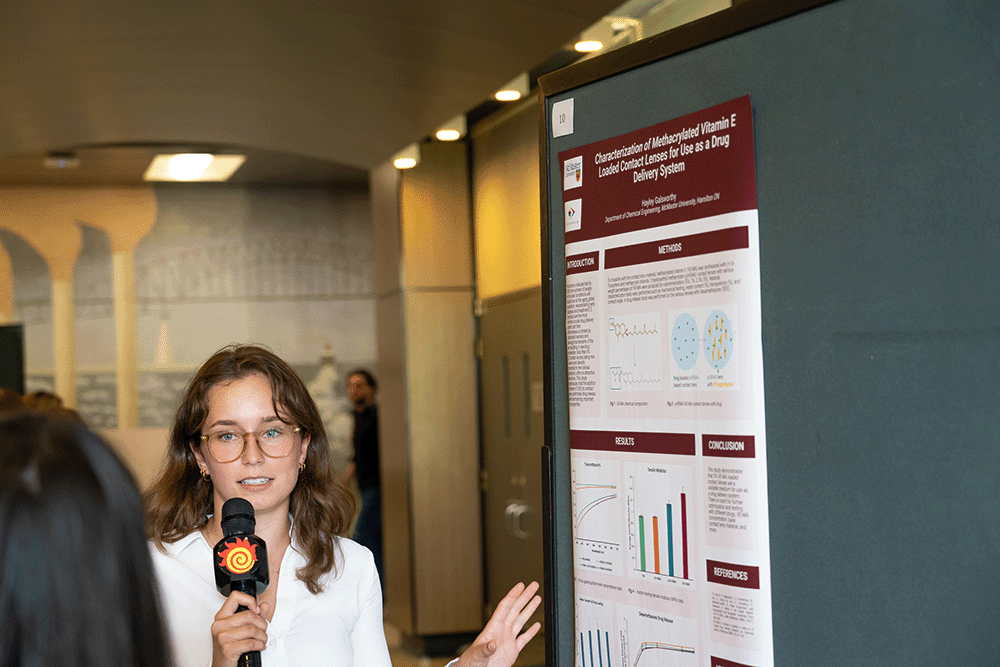
Characterization of Methacrylated Vitamin E Loaded Contact Lenses for Use as a Drug Delivery System
Hayley Galsworthy, Biomechanical Engineering Student from Queen’s University
Supervisor: Heather Sheardown
Tell us about your project.
My project focuses on the application of contact lenses for drug delivery. Typically, when drugs are added to contact lenses, they are quickly released, requiring the use of multiple lenses throughout the day to ensure the right drug dosage. In my project, I explored the use of vitamin E to slow down the drug release process from the contact lenses. Vitamin E forms aggregates within the contact lens material, effectively decelerating the drug release. This innovation allows for the use of a single contact lens over several consecutive days. Through various characterization tests and drug release studies, I confirmed the effectiveness of using vitamin E for sustained drug delivery with these contact lenses.
What are next steps in your research area?
Moving forward, our research will focus on optimizing the concentration of vitamin E. This involves determining the ideal concentrations that enhance drug delivery while maintaining the necessary mechanical and material properties of the contact lenses.
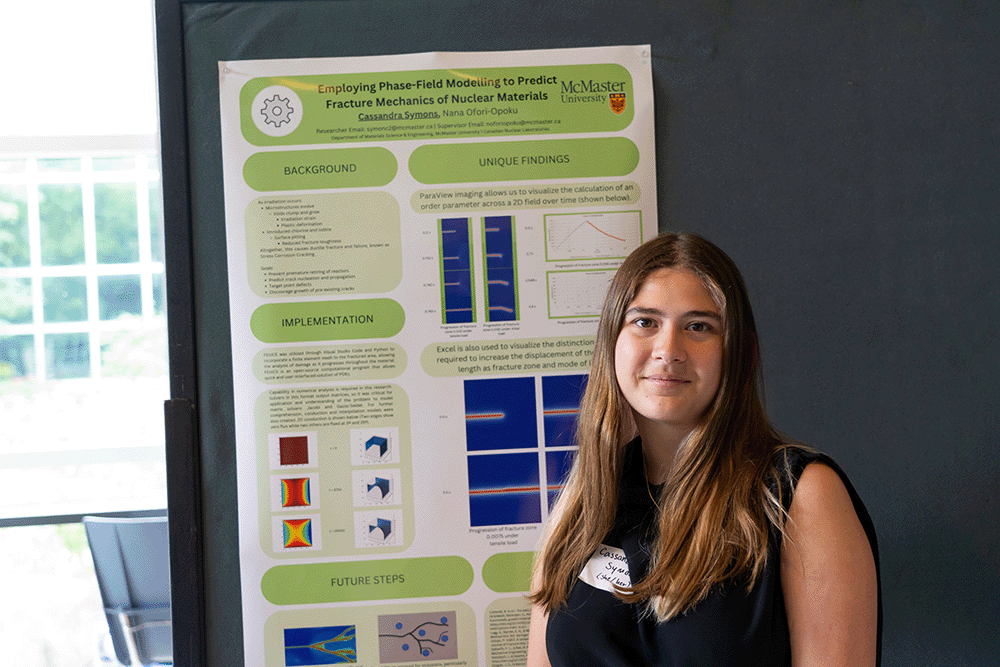
Employing Phase-Field Modelling to Predict Fracture Mechanics of Nuclear Materials
Cassandra Symons, Materials Engineering
Supervisor: Nana Ofori-Opoku
Tell us about your project.
My research is about the influence of fracture mechanics in terms of nuclear materials, specifically uranium dioxide. The aim is to understand how cracks propagate under various loads and crack lengths, and how these factors influence the material’s durability and long-term safety.
Do you have any advice for students who are interested in a summer research position?
For undergrads going into research, don’t be afraid to step a little bit outside of what you want to do in terms of long-term career. This is your chance to explore and learn new things. I didn’t know if I wanted to do nuclear, but here I am doing nuclear research and I love it.
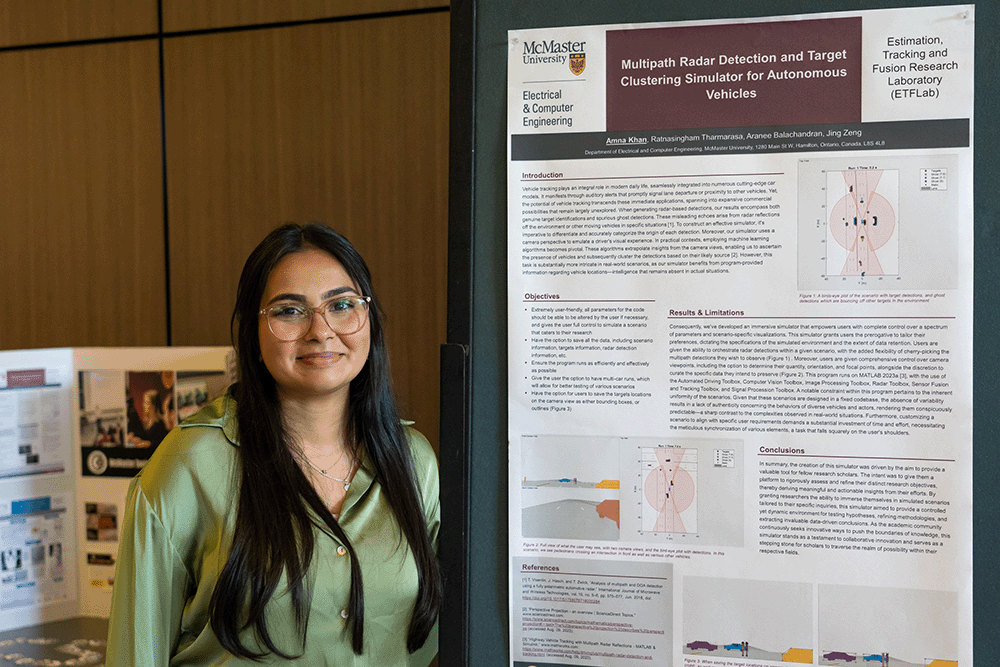
Multipath Radar Detection and Target Clustering Simulator for Autonomous Vehicles
Amna Khan, Aranee Balachandran and Jing Zeng, Electrical and Computer Engineering
Supervisor: Ratnasingham Tharmarasa
Tell us about your project.
I worked in the Estimation, Tracking and Fusion Research Laboratory (ETF), focusing on radar detections and vehicle simulation. I created a scenario where we get these detections, classifying them into genuine detections from real sources and ghost detections. Additionally, I worked on camera view simulators, which displayed detections within the actual image. An important part of my work was generating bounding boxes to pinpoint the locations of actual vehicles. This allowed students to differentiate between various actors instead of a single big actor. Overall, my project revolved around creating a comprehensive simulator to store valuable data for future research purposes.
What are some next steps in your research?
I’m aiming to make it even more versatile. While we currently have one big scenario, my goal is to diversify by incorporating different scenarios to simulate a wider array of real-world situations.
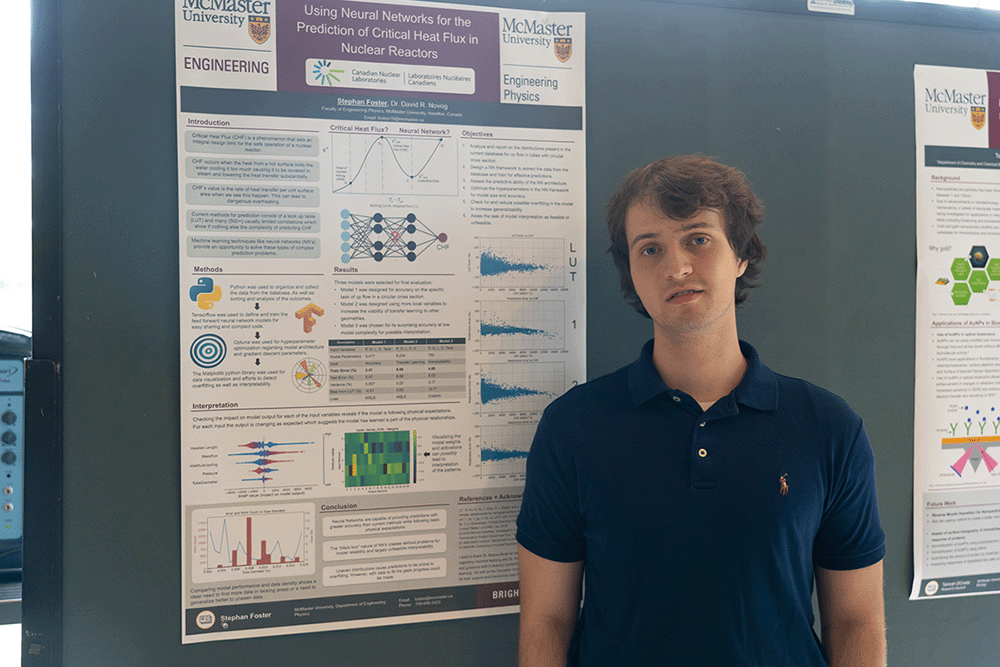
Using Neural Networks for the Prediction of Critical Heat Flux in Nuclear Reactors
Stephan Foster, Engineering Physics
Supervisor: David R. Novog
Tell us about your project.
My project is at the intersection of two exciting fields: neural networks, machine learning and AI as well as nuclear-focused research. One of the important things about approaching a problem with neural networks is that you need to make sure that it’s the right type of problem. Not every problem is solvable with the neural network, but identifying which problems are is a significant part of the issue. My main focus this summer was to determine whether a specific phenomenon in nuclear engineering can be addressed using neural networks. This relates to the specialized area of machine learning that I’m currently exploring.
What are some next steps in your research?
My next steps for this project would be to look at how we can reduce bias on the current data that we’re working on. The current data that we’re using to judge this problem is based on a very simple geometry. But if you want to apply it to a nuclear [reactor], you need to be able to work and apply it to a nuclear reactor core, which is a much more complex problem. If we’re able to generalize from smaller geometries, more simple functions, etc., we can possibly push it to make predictions on more complicated geometries like a nuclear reactor core.
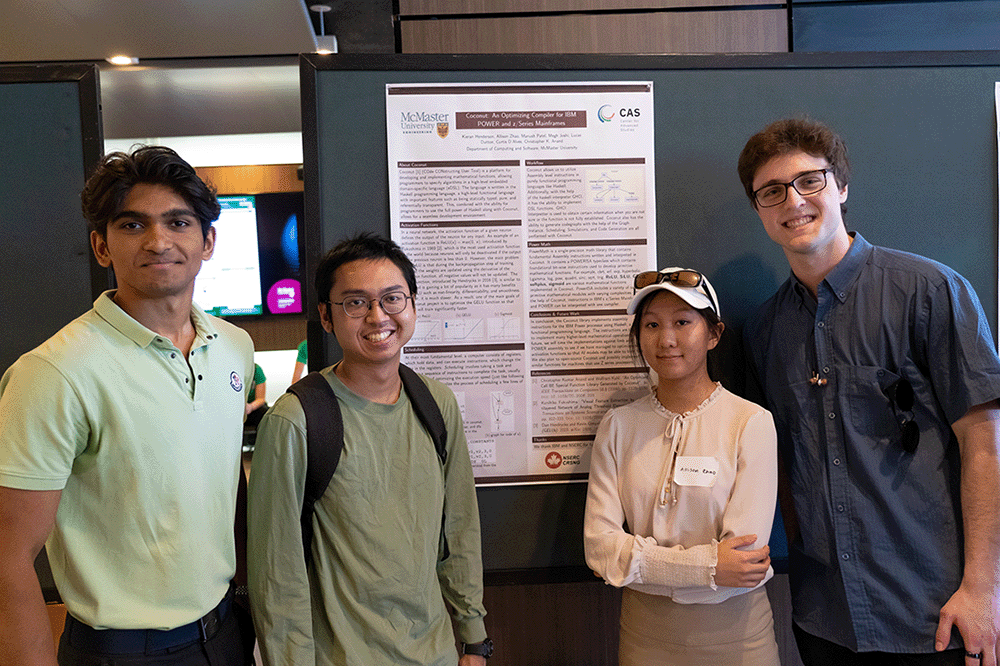
Coconut: An Optimizing Compiler for IBM POWER and z/Series Mainframes
Kieran Henderson, Allison Zhao, Manush Patel, Megh Joshi, Lucas Dutton and Curtis D’Alves, Computing and Software
Supervisor: Christopher Anand
Tell us about your project.
Our project is powered by IBM. IBM is known for its mainframes, with different types like the older Z series and the newer power series. Our task was to develop a compiler capable of efficiently compiling both mainframe types, resulting in one optimized compiler.
What are some next steps in your research?
This project has been ongoing for a decade, so it’s not something new. In the upcoming years, our focus will remain on further developing this compiler with the goal of eventually getting it published.

